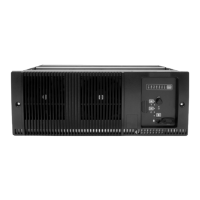82 Network Circuitry TB9100 Reciter Service Manual
© Tait Electronics Limited January 2006
5.9.1 +3.3V Switching Regulator
Firstly, consider the +3.3V switching regulator on the RHS of U900. This is
a conventional buck regulator with a synchronous rectifier to maximize
switching efficiency with low output voltages. MOSFET Q901a is switched
at a suitable duty cycle (approximately 3.3/28), to chop the input voltage to
produce the required average output voltage of 3.3V. Since Q901a is an
n-channel MOSFET, its gate must be pulled several volts above the input
supply to ensure it is fully saturated when switched on. An external boost
voltage circuit, C915 and D900, produces a gate supply, on pin BST2, that
swings at least 5V above the main supply rail. The internal gate driver for
the upper MOSFET is powered from this pin.
The synchronous rectifier, MOSFET Q901b, maintains current flow
through the inductor when the upper MOSFET is switched off. Since the
MOSFET has a lower voltage drop than the paralleled diode, D905,
efficiency is improved when it is switched on. Diode D905 carries the
inductor current only during the short transition period, switching between
the upper and lower MOSFETs.
The chopped waveform from the MOSFETs is filtered by L901 and C918
to produce a smooth DC output. The output voltage is fed back through
resistive divider R909 and R910 to close the control loop. These resistors
are proportioned to provide 0.8V, the internal reference voltage, when the
output voltage is 3.3V. Since U900 uses a current-mode control strategy, the
sensed output voltage does not directly control the switcher duty cycle, but,
instead, controls the average inductor current required to maintain the
specified output voltage. The inductor current is sensed by differentially
monitoring the voltage drop across R908.
Following the main filter, there is another filter, E902 and C929, to remove
residual high frequency noise. Bulk output capacitor C972 provides/sinks
current for short periods, until the control loop of the switching regulator
can restore normal regulation, to cover any sudden load changes.
The control loop of the regulator is stabilized by the loop compensation
components, C916, R906 and C926, which connect to the output of the
internal error amplifier.
5.9.2 +1.8V Switching Regulator
The 1.8V switcher on the LHS of U900 is identical to the 3.3V switcher,
except for changes to resistor values, to set the output voltage (R900 and
R901) and the current sense (R902). Because of the large step-down ratio
(28V/1.8V), the on time of the upper MOSFET, Q900a, is quite short.
To meet the minimum on time requirements of the switch-mode controller,
its operating frequency has to be set to its minimum, nominally 250KHz.
This is accomplished by grounding the PLL filter pin; U900 has an internal
PLL to synchronize its operating frequency to an external source, but this
mode of operation is not used in this design.

